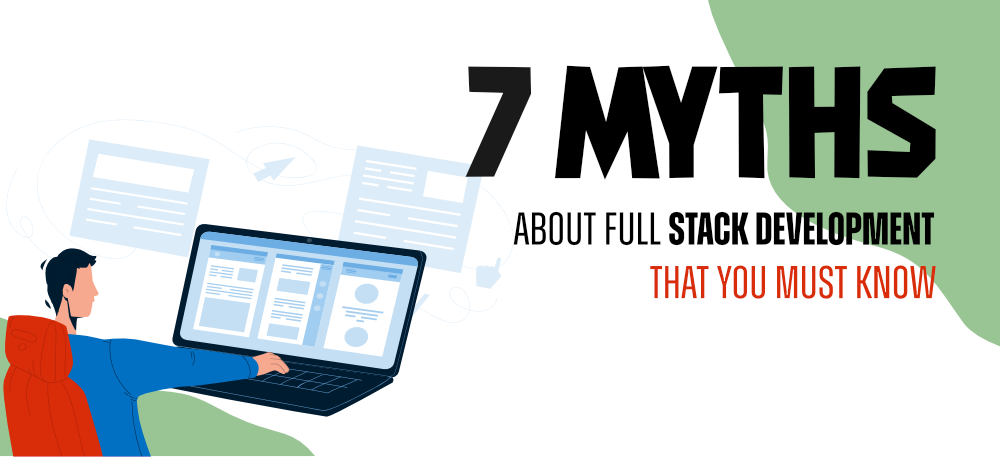7 Myths About Full Stack Development That You Must Know
Last Updated :
18 Oct, 2021
There aren’t enough developers out there with the skills for full-stack development anymore. Full-stack is not a one-size-fits-all solution. A full-stack developer is someone who works with both front-end and back-end code. A headless web application is a piece of software that doesn’t have a user interface. Those terms are often tossed around as buzzwords, but they can be useful to keep in mind as you talk about this industry. Every technology has its own set of myths, some of which are more damaging than others. For example, the myth that full-stack development is complex and hard is not only incorrect, but it’s also dangerous. It’s not as hard as you might think. It’s the same as any other coding role – you just need to learn a lot of different skills to do it correctly.

A lot of people think that they want to learn all of this on their own, but it’s usually too much for beginners. The best way to learn is by working with an expert who knows what he’s doing. Here are some of the most common myths we hear about full-stack development:
1. You Should Start with Front-End Skills
The fact that frontend skills are in high demand doesn’t mean you should use them as your starting point. As you gain experience, you should focus on areas where you lack knowledge and expertise, such as back-end or data management.
2. A Full-Stack Developer only Needs Technical Knowledge
It is wrong to assume that a full-stack developer only needs technical knowledge. There are other things to take into account as well, such as project management. Full-stack developers should have some knowledge of business aspects like marketing, sales, and operations. A full-stack developer should be able to write documentation for the product he/she is developing. In addition, a full-stack developer should have experience in handling all the stages of development from requirements gathering through deployment. They should also be familiar with different techniques and technologies used in each stage.
3. Full Stack Developers Should be Able to Write Code in any Language
The most popular one is that full-stack developers should be able to write code in any language they want or need to. There are some instances where this might be true, but it’s not the case for all languages. Many programmers don’t know how to write code in every language, so they go for the ones they think are easiest or most familiar to them. You should always be learning. Even if you’ve been working as a developer for five years, there’s always something new to learn. The more you know about programming, the more tools you’ll have at your disposal to build great products for your customers. You can’t outsmart yourself, and that means leveraging everything at your disposal to build the best product possible.
4. A Full Stack Developer Should be an Expert Coder/Programmer
A full-stack developer is a great, and very important, member of the team. But they’re not necessarily an expert coder or even a programmer. Full-stack developers can be responsible for coding the front end (the web pages and user interfaces), backend (database and server-side), and even marketing, design, and support. The most important thing they should be able to do is to code well. It’s true that many programming languages are becoming abstracted into what is known as “server-side” or “front end” languages that don’t require the user to know anything about programming whatsoever – but there’s still a lot of value in knowing how to code well.
5. All Full Stack Developers are the Same
Full-Stack developers are the most coveted of developers. In some ways, they’re also the most misunderstood. There’s a perception that all full-stack developers do the same things and have the same skillset. The reality is that there are many different ways to build a full-stack application, depending on the technical approach and the project requirements. This is not to say that one approach or method is better than another; it’s just that each choice has its own pros and cons.
6. Only Learning JavaScript Can Make You Full-Stack Developer
Front-end developers may use JavaScript as their primary programming language or as a secondary language, but it’s not the only one they use. They also use languages such as Python, PHP, and others to interact with back-end systems. A full-stack developer may write code in multiple languages or even develop an application in a different language altogether.
7. Coding is Everything
The ability to write code is not enough. A junior developer may be able to write some very basic code, but if they don’t have the ability to communicate with the customer through design documents, they won’t be able to deliver a product. If there is no documentation for the front-end or the back-end, how do you know what you are building?
Several other popular myths about Full Stack Development are Full Stack Developers should be experts in everything, Full-stack developers are more intelligent, Full stack developers should understand all the pieces of an app, etc. The myths about full-stack development are endless; there is no end. So, start with basics and never stop learning!
Like Article
Suggest improvement
Share your thoughts in the comments
Please Login to comment...